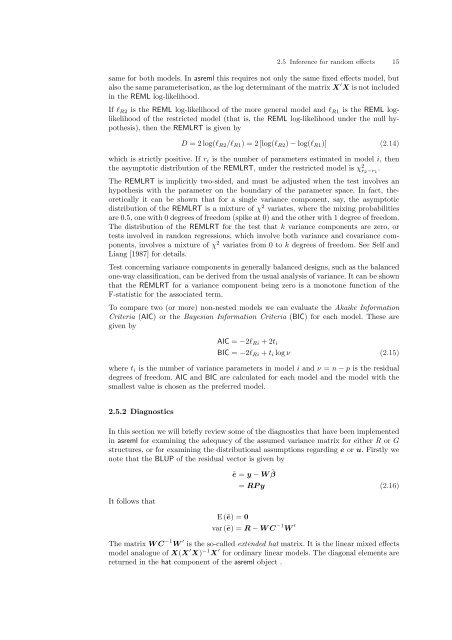ASReml-S reference manual - VSN International
ASReml-S reference manual - VSN International
ASReml-S reference manual - VSN International
- No tags were found...
Create successful ePaper yourself
Turn your PDF publications into a flip-book with our unique Google optimized e-Paper software.
2.5 Inference for random effects 15same for both models. In asreml this requires not only the same fixed effects model, butalso the same parameterisation, as the log determinant of the matrix X ′ X is not includedin the REML log-likelihood.If l R2 is the REML log-likelihood of the more general model and l R1 is the REML loglikelihoodof the restricted model (that is, the REML log-likelihood under the null hypothesis),then the REMLRT is given byD = 2 log(l R2 /l R1 ) = 2 [log(l R2 ) − log(l R1 )] (2.14)which is strictly positive. If r i is the number of parameters estimated in model i, thenthe asymptotic distribution of the REMLRT, under the restricted model is χ 2 r 2 −r 1.The REMLRT is implicitly two-sided, and must be adjusted when the test involves anhypothesis with the parameter on the boundary of the parameter space. In fact, theoreticallyit can be shown that for a single variance component, say, the asymptoticdistribution of the REMLRT is a mixture of χ 2 variates, where the mixing probabilitiesare 0.5, one with 0 degrees of freedom (spike at 0) and the other with 1 degree of freedom.The distribution of the REMLRT for the test that k variance components are zero, ortests involved in random regressions, which involve both variance and covariance components,involves a mixture of χ 2 variates from 0 to k degrees of freedom. See Self andLiang [1987] for details.Test concerning variance components in generally balanced designs, such as the balancedone-way classification, can be derived from the usual analysis of variance. It can be shownthat the REMLRT for a variance component being zero is a monotone function of theF-statistic for the associated term.To compare two (or more) non-nested models we can evaluate the Akaike InformationCriteria (AIC) or the Bayesian Information Criteria (BIC) for each model. These aregiven byAIC = −2l Ri + 2t iBIC = −2l Ri + t i log ν (2.15)where t i is the number of variance parameters in model i and ν = n − p is the residualdegrees of freedom. AIC and BIC are calculated for each model and the model with thesmallest value is chosen as the preferred model.2.5.2 DiagnosticsIn this section we will briefly review some of the diagnostics that have been implementedin asreml for examining the adequacy of the assumed variance matrix for either R or Gstructures, or for examining the distributional assumptions regarding e or u. Firstly wenote that the BLUP of the residual vector is given byIt follows thatẽ = y − W ˜βE (ẽ) = 0= RP y (2.16)var (ẽ) = R − W C −1 W ′The matrix W C −1 W ′ is the so-called extended hat matrix. It is the linear mixed effectsmodel analogue of X(X ′ X) −1 X ′ for ordinary linear models. The diagonal elements arereturned in the hat component of the asreml object .
















